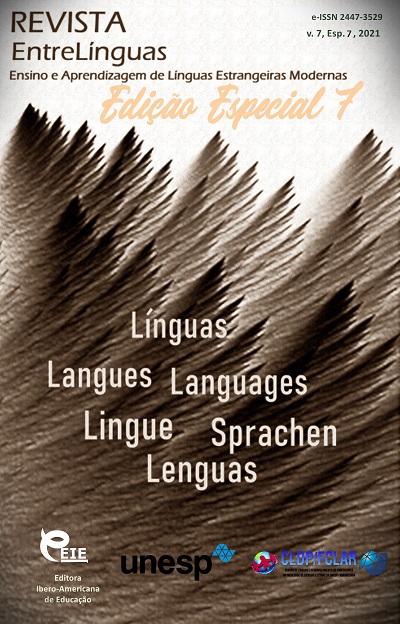Lexical features of the french language in Ivory Coast
DOI:
https://doi.org/10.29051/el.v7iesp.7.16280Keywords:
Language variation, Ivory Coast, Indigenous languages, French, Loanwords, Borrowing, Diglossia, InterferenceAbstract
The article deals with the peculiarities of identifying the lexical features of the French language functioning on the territory of Ivory Coast, one of the West African. The research work focuses on a deep analysis of linguistic processes which are manifested in the study under the influence of a complex factors and its peculiar features hence to the process of language and cultural adaptation to the territorial needs of Ivory Coast. The article deals with the analyses of language situation’s peculiarities in Ivory Coast, with the French language domination process in various spheres of life. The authors stress, the Ivorian French variant is the hybrid mixture of a formation based on the French language, supplemented by elements of Ivorian local languages. The practical work part is based on the analysis of the examples of lexical interference and borrowings from indigenous languages, presenting the specific features of Ivorian French. The results of the research work prove, the French language has a wide range of words denoting local realities and reflecting the adaptation of the French language to the Ivorian culture peculiarities. All in all, French words with new lexical meanings and words from indigenous languages are widely used by the population of Ivory Coast.
Downloads
References
ADIAFFI, J.M. The castaways of intelligence (roman n'zassa). Abidjan: CEDA. 325 p. 2000.
BAGHANA, J., KHAPILINA, E. Contact linguistics. The interaction of languages and bilingualism. Moscow: Flinta. 123 p. 2010.
BLYAGOZ, Z.U. Bilingualism and its role in teaching and upbringing of schoolchildren. Bilingualism is a sociocultural problem: materials of the round table. Maykop, Pp. 7-11. 2003.
FERGUSON, CH. Diglossia. In Vakhtin, N. B. (ed.) Sociolinguistics and sociology of language. SPb. St. Petersburg: Publishing House of the European University in St. Petersburg. Pp. 43-62. 2012.
FISHMAN, J. A. Bilingualism with and without diglossia; diglossia with and without bilingualism.In L. Wei (ed.). The Bilingualism Reader. London: Routledge, Pp. 89-106. 2000.
KHABIROV, V.P. Language contacts while maintaining the community language: interference and borrowing. Linguistic readings 2008. Perm. Pp.16-23. 2008.
KRYSIN, L. P. The borrowed word as a translator of another culture. In Neshchimenko G.P. (ed.) Globalization - ethnization: Ethnocultural and ethno-linguistic processesed. Moscow: Science. Pp.106–113. 2006.
LAFAGE, S. The French lexicon of Ivory Coast: appropriation and creativity. French in Africa No 17. I.L.F-CNRS. Nice. Vol 1. 864 p. 2003.
Linguistic Encyclopedic Dictionary 2002. In Yartseva V.N. (ed.). Moscow: Great Russian Encyclopedia. 709 p.
MACKEY, W. Bilingualism and Contact of Languages. - Paris: Klinksieck. 397 p. 1976.
MANESSY, G. Pratique du français en Afrique noire francophone. Langue française. Le français en afrique noire, fait d'appropriation, 104. Pp. 11-19. 1994.
Mechkovskaya, N.B. Social linguistics. Moscow: Aspect Press, 207 p. 2000.
SCOLLON, R., SCOLLON S.W. Intercultural communication: a discourse approach. N.Y.: Blackwell Publishers Ltd., 316 p. 1995.
SIMONS, G.F., FENNIG, C.D. Ethnologue: Languages of the World. Texas: SIL International. P. 33. 2017.
THOMASON, S.G., KAUFMAN T. Language Contact, Creolization and Genetic Linguistics. Berkeley: University of California Press. – 411 p. 1992.
VINOGRADOV, V.A. Diglossia. The Big Russian Encyclopaedia. Vol. 8. Moscow, P. 728. 2007.
WEINREICH, U. Language contacts. Research status and problems. Blagoveshchensk, 260 p. 2000.
WIERZBICKA, A. Understanding cultures through the mediation of keywords. Moscow: Slavic Culture Languages. P.108. 2001.
Downloads
Published
How to Cite
Issue
Section
License

This work is licensed under a Creative Commons Attribution-NonCommercial-ShareAlike 4.0 International License.
Os manuscritos aceitos e publicados são de propriedade da Revista EntreLínguas. Os artigos publicados e as referências citadas na Revista EntreLínguas são de inteira responsabilidade de seus autores.
Transferência de direitos autorais – autorização para publicação
Caso o artigo submetido seja aprovado para publicação, já fica acordado que o(s) autor(es) autoriza(m) a UNESP a reproduzi-lo e publicá-lo na EntreLínguas, entendendo-se os termos “reprodução” e “publicação” conforme definição respectivamente dos incisos VI e I do artigo 5° da Lei 9610/98. O artigo poderá ser acessado pela rede mundial de computadores (Internet), sendo permitidas, a título gratuito, a consulta e a reprodução de exemplar do artigo para uso próprio de quem a consulta, desde que haja a citação ao texto consultado. Essa autorização de publicação 328 EntreLínguas, Araraquara, v. 1, n .2, p. 323-328, jul./dez. 2015 não tem limitação de tempo, ficando a UNESP responsável pela manutenção da identificação do(s) autor(es) do artigo. Os artigos publicados e as referências citadas na Revista EntreLínguas são de inteira responsabilidade de seus autores.











